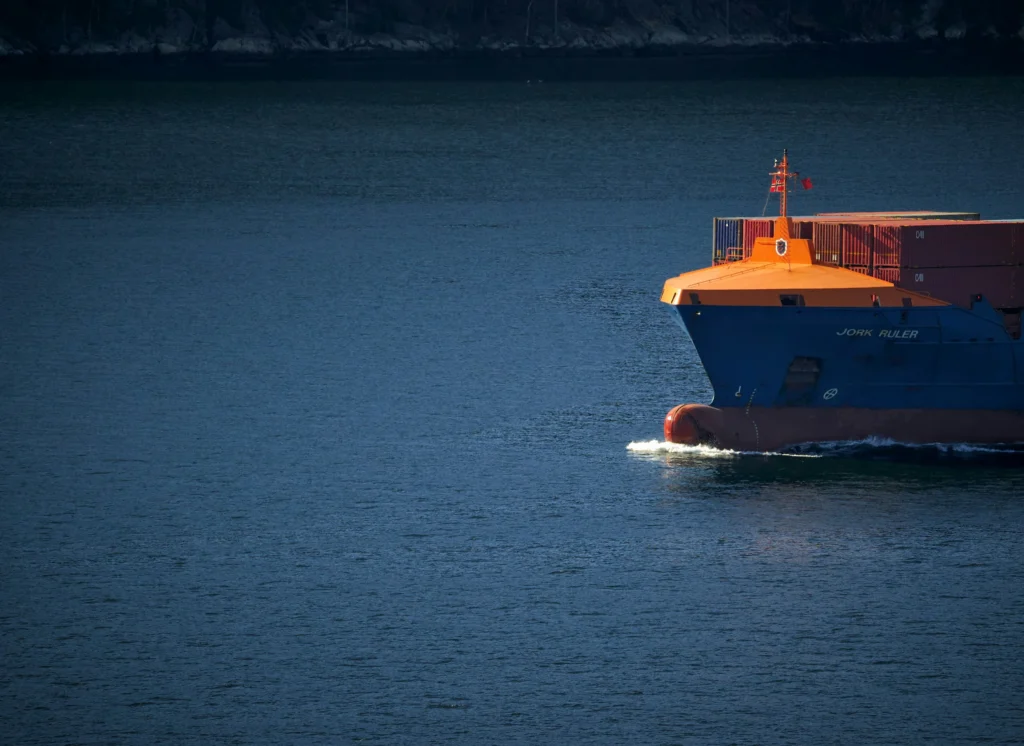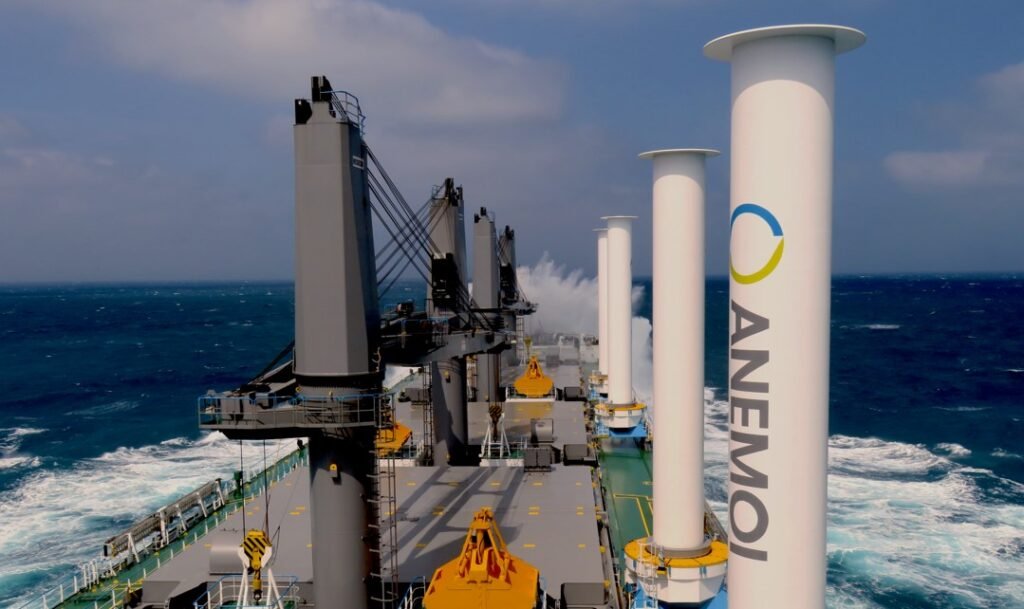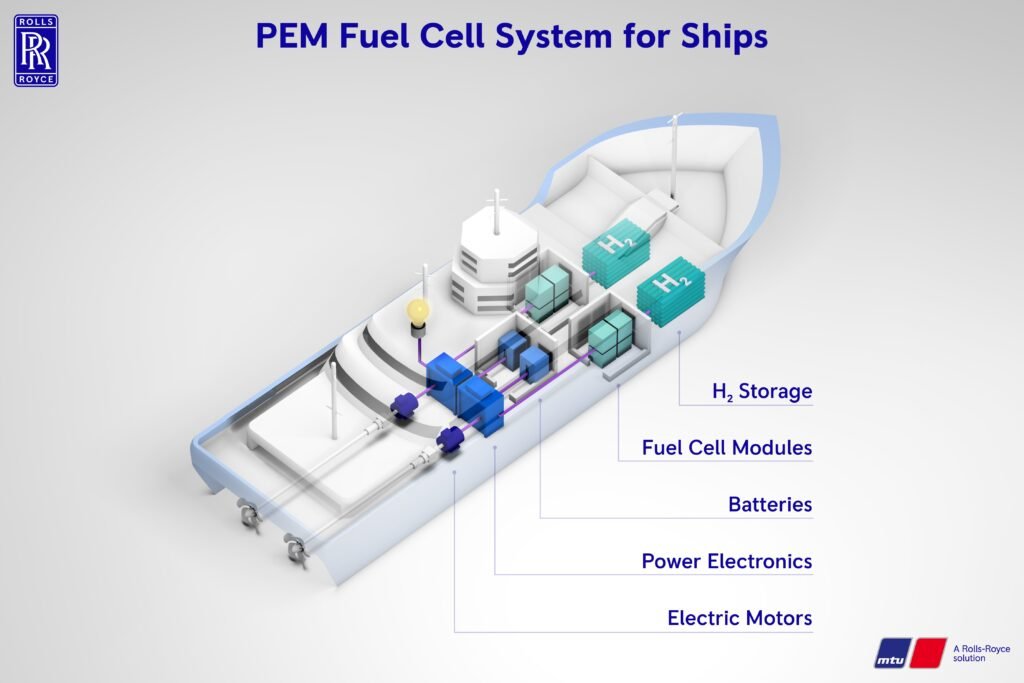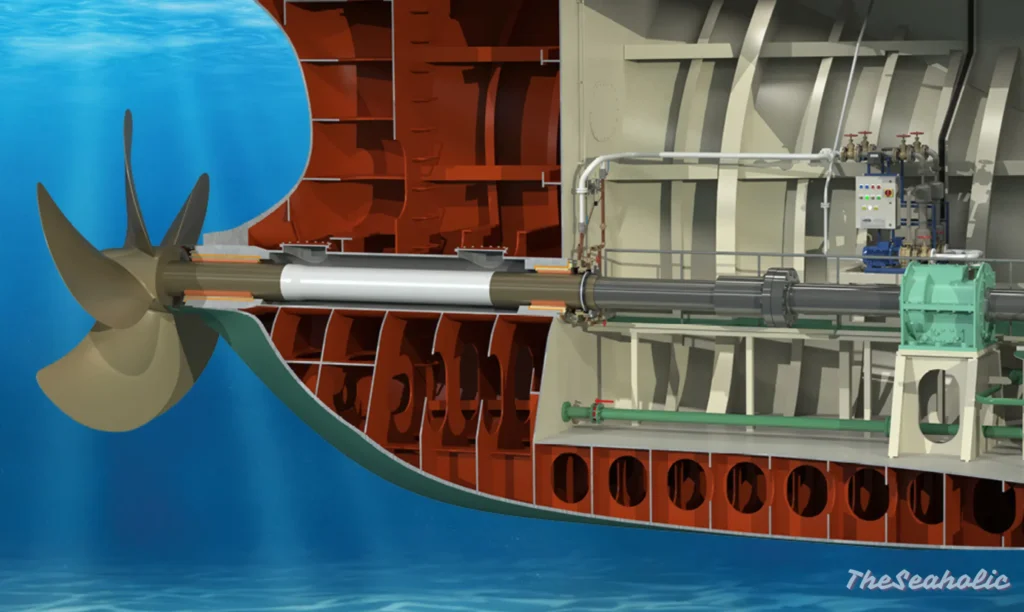A propulsion system onboard a ship is the mechanism or system that generates the power needed to move the vessel through the water. It converts energy into thrust, which propels the ship forward. The propulsion system can include engines, propellers, and other components that work together to provide the necessary force to move the ship.
Different types of ships may use different propulsion systems based on factors such as size, speed, efficiency, and environmental impact.
Using propulsion forces, ships are able to manoeuvre themselves in the water. Initially while there were limited number of ship propulsion systems, in the present era there are several innovative ones with which a vessel can be fitted with.
Today ship propulsion is not just about successful movement of the ship in the water. It also includes using the best mode of propulsion to ensure a better safety standard for the marine ecosystem along with cost efficiency.
Types of propulsion systems used in ships are as follows:
- Steam Turbines: Historically, steam turbines were widely used for propulsion. However, they are less common today due to advances in other technologies.
- Diesel Engines: Most modern ships use diesel engines for propulsion. These engines can be quite large and are often used in combination with electric propulsion systems.
- Gas Turbines: Gas turbines are another option for ship propulsion, especially in military vessels and high-speed ships. They offer a good power-to-weight ratio.
- Nuclear Power: Some military ships and icebreakers use nuclear reactors for propulsion. Nuclear power provides a long endurance and high power output.
- Electric Propulsion: Electric propulsion systems use electric motors to drive the propeller shafts. They are efficient and offer good maneuverability.
- Hybrid Systems: Hybrid propulsion systems combine different power sources, such as diesel engines and batteries, to optimize fuel efficiency and reduce emissions.
- Wind Propulsion: While not common in large ships, wind propulsion systems like sails or rotors can supplement traditional propulsion systems to reduce fuel consumption.
- LNG Propulsion: Ships can also be powered by liquefied natural gas (LNG), which is becoming more popular due to its lower emissions compared to traditional fuels.
Types of propulsion systems Explained further
1. Diesel Propulsion

Diesel propulsion system is the most commonly used marine propulsion system converting mechanical energy from thermal forces. Diesel propulsion systems are mainly used in almost all types of vessels along with small boats and recreational vessels.
Diesel propulsion is a common type of propulsion system used in ships, especially in commercial vessels. It involves the use of diesel engines to generate power, which is then used to drive the ship’s propellers.
In a diesel propulsion system, diesel fuel is combusted in cylinders within the engine, creating high-pressure gases that drive pistons. The pistons, in turn, drive a crankshaft, which is connected to the ship’s propeller shafts. As the crankshaft rotates, it turns the propeller shafts, causing the propellers to rotate and propel the ship forward through the water.
Diesel propulsion is favored for its efficiency, reliability, and relatively low operating costs compared to other propulsion systems. However, diesel engines can produce emissions that contribute to air pollution, so efforts are often made to reduce their environmental impact through the use of cleaner fuels or exhaust treatment systems.
2. Steam Turbine Propulsion
Steam turbine propulsion is a type of propulsion system that uses steam turbines to generate power and propel a ship forward. This technology was widely used in the past but has become less common in modern ships due to the prevalence of diesel engines and other propulsion systems.
In a steam turbine propulsion system, steam is generated in a boiler by heating water using a heat source such as oil, gas, or nuclear energy. The high-pressure steam is then directed to a steam turbine, where it expands and rotates the turbine blades. The rotating turbine is connected to a shaft that drives the ship’s propeller, creating thrust and propelling the ship forward.
Steam turbine propulsion systems are known for their high efficiency and power output. However, they require a large amount of space for the boiler and other components, making them less suitable for smaller ships. Additionally, the complexity and maintenance requirements of steam turbine systems have led to their decline in favor of more modern propulsion technologies.
DO YOU KNOW? The Titanic was propelled by a pair of reciprocating steam engines that exhausted their steam into a single steam turbine.
3. Wind Propulsion

Wind propulsion emerged as an alternative to those systems which emit huge quantities of CO2 gases in the marine atmosphere. However, the usage of wind turbine marine propulsion has not started extensively in large commercial ships because of a requirement of constant windiness. Two wind propulsion systems for ships that have become lately are- kite propulsion and sail propulsion for merchant ships.
4. Nuclear Propulsion

Nuclear propulsion is a propulsion system used in some ships, particularly naval vessels and icebreakers, that uses a nuclear reactor to generate heat. This heat is used to produce steam, which then drives turbines connected to propellers, providing thrust to propel the ship forward.
Nuclear propulsion offers several advantages, including long endurance without refueling, high power output, and the ability to operate at high speeds for extended periods. These benefits make nuclear propulsion ideal for certain types of vessels that require long-range, high-speed capabilities, such as aircraft carriers and submarines.
However, nuclear propulsion also has drawbacks, including high initial costs, complex infrastructure and safety requirements, and concerns about nuclear proliferation and environmental impact. As a result, nuclear propulsion is not widely used in commercial shipping but remains an important technology for certain specialized applications.
5. Gas Turbine Propulsion

Gas turbine propulsion is a type of propulsion system used in some ships, particularly high-speed vessels and naval ships. It uses a gas turbine engine to generate power, which is then used to drive the ship’s propellers.
In a gas turbine propulsion system, air is compressed and mixed with fuel in a combustion chamber. The fuel-air mixture is ignited, and the resulting hot gases are directed through a turbine, causing it to spin. The turbine is connected to the ship’s propeller shafts, so as the turbine spins, it drives the propellers, generating thrust and propelling the ship forward.
Gas turbine propulsion systems offer several advantages, including high power-to-weight ratios, rapid acceleration, and the ability to operate at high speeds. However, they can be less fuel-efficient than other propulsion systems, especially at lower speeds, and they can produce significant amounts of heat and noise.
Despite these drawbacks, gas turbine propulsion is favored for certain applications where high speed and agility are important, such as in military vessels and fast ferries.
6. Fuel Cell Propulsion

Fuel cell propulsion is an emerging technology used in some ships to generate power and propel the vessel. It involves the use of fuel cells, which convert chemical energy from a fuel, typically hydrogen, into electricity through an electrochemical process.
In a fuel cell propulsion system, hydrogen gas is fed into the fuel cell, where it reacts with oxygen from the air to produce electricity, water, and heat. The electricity generated by the fuel cells is then used to power electric motors connected to the ship’s propellers, providing thrust and propulsion.
Fuel cell propulsion offers several advantages, including high efficiency, zero emissions of greenhouse gases and pollutants (when hydrogen is used as the fuel), and low noise levels. However, there are challenges associated with fuel cell propulsion, including the need for hydrogen storage and infrastructure, as well as the high cost of fuel cells compared to other power sources.
Despite these challenges, fuel cell propulsion is being increasingly explored and adopted for use in ships, particularly in applications where reducing emissions and environmental impact are priorities.
7. Biodiesel Fuel Propulsion

Biodiesel fuel propulsion is a type of propulsion system that uses biodiesel fuel derived from renewable sources such as vegetable oils or animal fats. Biodiesel is a cleaner-burning alternative to traditional diesel fuel, and it can be used in diesel engines with little to no modifications.
In a biodiesel fuel propulsion system, biodiesel is used as the fuel in diesel engines onboard the ship. The biodiesel is combusted in the engine, producing power that drives the ship’s propellers and propels the vessel forward.
Biodiesel fuel propulsion offers several environmental benefits, including reduced emissions of pollutants such as particulate matter, carbon monoxide, and sulfur dioxide compared to traditional diesel fuel. Additionally, biodiesel is biodegradable and non-toxic, making it a more environmentally friendly option.
However, there are also challenges associated with biodiesel fuel propulsion, including the availability and cost of biodiesel fuel compared to traditional diesel fuel, as well as concerns about its impact on engine performance and durability. Despite these challenges, biodiesel fuel propulsion is being increasingly used in ships as part of efforts to reduce emissions and transition to more sustainable fuel sources.
8. Solar Propulsion
Solar propulsion is a propulsion system that uses solar energy to generate power and propel a ship forward. This technology typically involves the use of solar panels or solar cells to capture sunlight and convert it into electricity, which is then used to power electric motors connected to the ship’s propellers.
In a solar propulsion system, solar panels are mounted on the ship’s deck or other suitable surfaces to capture sunlight. The solar panels convert the sunlight into electricity, which is stored in batteries or used to power the ship’s propulsion system directly. The electricity generated by the solar panels can also be used to power other onboard systems, such as lighting, navigation equipment, and communication systems.
Solar propulsion offers several advantages, including the use of a renewable energy source, zero emissions of greenhouse gases and pollutants during operation, and reduced operating costs compared to traditional fuel-powered propulsion systems. However, the effectiveness of solar propulsion can be limited by factors such as weather conditions, ship size, and energy storage capacity.
Despite these limitations, solar propulsion is being increasingly explored and adopted for use in ships, particularly in small vessels and ferries operating in coastal areas where sunlight is abundant. Advances in solar panel technology and energy storage systems are helping to improve the efficiency and viability of solar propulsion for a wider range of marine applications.
9. Diesel-Electric Propulsion

Diesel-electric propulsion is a propulsion system that uses diesel generators to produce electricity, which is then used to power electric motors connected to the ship’s propellers. This system is different from traditional direct mechanical drive systems, where the diesel engine is directly connected to the propeller shaft.
In a diesel-electric propulsion system, diesel fuel is burned in diesel generators to produce electricity. This electricity is then distributed to electric motors, which drive the propellers. This setup offers several advantages, including increased flexibility in the placement of propulsion components, improved fuel efficiency, and better control over the speed and direction of the ship.
Diesel-electric propulsion is commonly used in a variety of ships, including cruise ships, ferries, and icebreakers, due to its efficiency and flexibility. It also allows for the integration of other power sources, such as batteries or fuel cells, to further improve efficiency and reduce emissions.
10. Water-Jet Propulsion
Water-jet propulsion is a propulsion system used in some ships that uses high-pressure water to propel the vessel forward. This system is different from traditional propeller-based propulsion systems and offers several advantages, including increased maneuverability, reduced draft, and improved efficiency at high speeds.
In a water-jet propulsion system, water is drawn into the intake of the propulsion unit and then forced out through a nozzle at high pressure. The force of the water jet exiting the nozzle creates thrust that propels the ship forward. The direction of the thrust can be controlled by steering the nozzle, allowing for precise maneuvering.
Water-jet propulsion systems are commonly used in high-speed ferries, patrol boats, and other vessels where maneuverability and speed are important. They are also used in ships operating in shallow waters, as the lack of external propellers reduces the risk of damage from underwater obstacles.
11. LNG Fueled Propulsion

LNG-fueled propulsion refers to a propulsion system in which liquefied natural gas (LNG) is used as the primary fuel to power a ship. This type of propulsion system is becoming increasingly popular in the maritime industry due to its lower emissions and cost-effectiveness compared to traditional marine fuels.
In an LNG-fueled propulsion system, LNG is stored onboard the ship in insulated tanks. The LNG is then vaporized and fed into engines, which can be either dual-fuel engines capable of running on both LNG and diesel or dedicated LNG engines. The LNG is combusted in the engines to generate power, which drives the ship’s propellers.

LNG-fueled propulsion offers several environmental benefits, including significant reductions in sulfur oxide (SOx), nitrogen oxide (NOx), and particulate matter emissions compared to traditional marine fuels. LNG also produces fewer greenhouse gas emissions, making it a more environmentally friendly option for ship propulsion.
Overall, LNG-fueled propulsion is seen as a promising solution for reducing emissions from the shipping industry and complying with increasingly stringent environmental regulations.
12. Nuclear power propulsion
Nuclear power propulsion, also known as nuclear marine propulsion, is a propulsion system used in some ships that utilizes a nuclear reactor to generate steam, which is then used to power turbines connected to the ship’s propellers. This technology is primarily used in naval vessels, such as aircraft carriers and submarines, due to its ability to provide long-lasting, high-power propulsion without the need for frequent refueling.
In a nuclear power propulsion system, the nuclear reactor generates heat through nuclear fission reactions. This heat is used to produce steam, which drives turbines to generate electricity. The electricity is then used to power the ship’s propulsion system, as well as other onboard systems.
Nuclear power propulsion offers several advantages, including long operational range, high speed, and the ability to operate for long periods without refueling. However, it also poses challenges, including high initial costs, complex regulatory requirements, and concerns about nuclear safety and environmental impact.

Also Read, Large ocean-going ships are the perfect fit for nuclear propulsion
Despite these challenges, nuclear power propulsion remains a critical technology for certain types of ships that require long-range, high-speed capabilities. Advances in nuclear reactor technology and safety systems continue to improve the efficiency and safety of nuclear power propulsion for marine applications.
The various types of propulsion systems offer their own unique advantages to a vessel. Depending on the necessity and the requirement, the best type of ship propulsion system needs to be fitted. Only then the vessel will be able to offer its optimum service capacitance.
You may also like,
- Top 10 Largest Ship Propellers In The World
- Why Container Ship ‘DALI’ collided with Baltimore bridge
- Why Do Ships Have A Bulbous Bow – Advantages & Disadvantages

